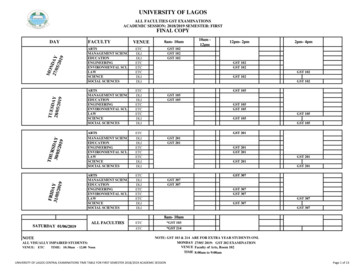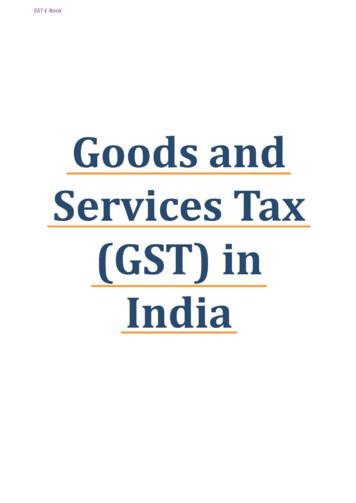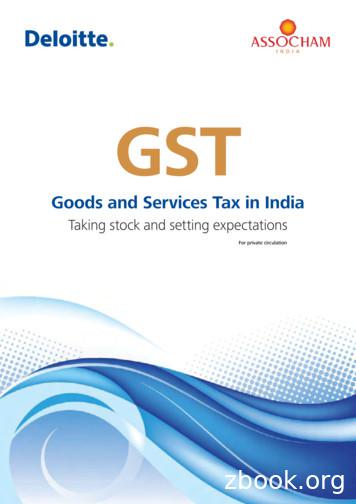GOODS & SERVICES TAX (GST) - Taxmann
GOODS &SERVICES TAX(GST)1
PRESENTATION PLAN WHY GST : PERCEIVED BENEFITS EXISTING INDIRECT TAX STRUCTURE FEATURES OF CONSTITUTION AMENDMENT BILL FEATURES OF PROPOSED GST MODEL FEATURES OF DRAFT GST LAW GSTN ROLE OF CBEC WAY FORWARD2
WHY GST?PERCEIVED BENEFITS3
WHY GST : PERCEIVED BENEFITS To Trade Reduction in multiplicityof taxesMitigation of cascading/double taxationMoreefficientneutralization of taxesespecially for exportsDevelopment of commonnational marketSimpler tax regime Fewer rates and exemptionsDistinction between Goods& Services no loner required To Consumers Simpler Tax systemReduction in prices ofgoods & services due toelimination of cascadingof taxesUniformpricesthroughout the countryTransparencyintaxation systemIncrease in employmentopportunities4
EXISTING INDIRECT TAXSTRUCTURE5
EXISTING INDIRECT TAX STRUCTUREEntry Tax & OctroiCustomsDutyExciseDutyEntertainment TaxElectricity DutyCentralLeviesCentralCessSalesTaxLuxury TaxServiceTaxVATStateLevies6
FEATURES OFCONSTITUTIONAMENDMENT BILL (CAB)7
FEATURES OF CAB . CAB passed by Rajya Sabha on 03.08.2016 & Lok Sabha on08.08.2016Key Features: Concurrent jurisdiction for levy & collection of GST by the Centre& the States – Article 246ACentre to levy & collect IGST on supplies in the course of interState trade or commerce including imports – Article 269A to be apportioned between Union & States on recommendationsof the GST Council (GSTC)Parliament to have powers to formulate principles fordetermining when a supply takes place in course of inter-statetrade or commerce8
.FEATURES OF CAB . Key Features contd. Compensation for loss of revenue to States for five years onrecommendation of GSTC – Clause 19GST defined as any tax on supply of goods or services or bothother than on alcohol for human consumption – Article 366(12A)Goods includes all materials, commodities & articles – Article366 (12)Services means anything other than goods – Article 366 (26A)GST on petroleum crude, high speed diesel, motor spirit(commonly known as petrol), natural gas & aviation turbinefuel to be levied from a later date on recommendations ofGSTC9
.FEATURES OF CAB . Key Features contd. GSTC - Article 279A To be constituted by the President within 60 days from thecoming into force of the Constitution Amendment Consists of Union FM & Union MOS (Rev) Consists of Ministers in charge of Finance / Taxation of eachState Chairperson – Union FM Vice Chairperson - to be chosen amongst the Ministers of StateGovernment Quorum is 50% of total members Decisions by majority of 75% of weighted votes of memberspresent & voting10
.FEATURES OF CAB Key Features contd. GSTC - proposed Article 279A Weightage of votes:oo Council to be guided by need foroo Centre – 1/3rd of total votes castStates (all taken together) – 2/3rd of total votes casta harmonized structure of GST; anda harmonized national market for goods & servicesCouncil to make recommendations onoooooTaxes, etc. to be subsumed in GSTExemptions & thresholdsGST ratesBand of GST ratesModel GST Law & procedures11
FEATURES OF PROPOSEDGST MODEL12
GST – FEATURES . Destination-based Consumption TaxationApplies to all supplies of goods / services (as againstmanufacture, sale or provision of service) made for aconsideration except – Dual GST having two concurrent components Exempted goods / services – common list for CGST & SGSTGoods / services outside the purview of GSTTransactions below threshold limitsCentral GST (CGST) levied & collected by CentreState GST (SGST) levied & collected by StatesCGST & SGST on intra-State supplies of goods / services in India13
.GST – FEATURES . IGST levied & collected by the Centre applicable to Export of goods / services – Zero ratedAll goods or services likely to be covered under GST except: Inter-State supplies of goods / services in IndiaInter-state stock transfers of goodsImport of goods / servicesExport of goods / services (if made on payment of GST under claim ofrebate)Alcohol for human consumption - State Excise VATElectricity - Electricity DutySale / purchase of Real Estate - Stamp Duty Property TaxesFive specified petroleum Products – to be brought under GST froma later date on recommendation of GSTC14Tobacco Products – under GST Central Excise
.GST – FEATURES .CentralExcisedutyAdditionalduties ofexciseSurcharge &CessesCentralTaxesServiceTaxAdditionalduties ofcustoms (CVD& SAD)Surcharges &CessesStateTaxesPurchaseTaxExcise dutylevied underMedicinal &ToiletriesPreparationActStateVAT /Sales TaxEntryTaxLuxuryTaxEntertainmentTax (not leviedby local bodies)CentralSalesTaxTaxes onlottery,betting &gamblingCentral & State Taxes to be subsumed in GST15
.GST – FEATURES . GST Rates – based on RNR : Four rates Merit rate - essential goods or servicesStandard rate - goods or services in generalSpecial rate - precious metalsNil rate - exempted goods or servicesFloor rate with a small band of rates for standard rated goods /services for CGST & SGSTOptional Threshold exemption in both components of GSTOptional Compounding scheme for taxpayers having taxableturnover up to a certain threshold above the exemption16
.GST – FEATURES .Utilization of Input Tax Credit (ITC)ITCCGSTCGSTIGSTSGSTIGSTSGSTIGSTIGSTCGSTSGST17
FEATURES OF DRAFT GSTLAW (MGL)18
FEATURES OF MGL . Tax on supply of goods or services rather than manufacture /production of goods, provision of services or sale of goodsPowers to declare certain supplies as supply of goods or of services orof neither – Schedule IIOn Intra-State supplies of goods and/ or services - CGST & SGST shallbe levied by the Central and State Government respectively, at the rateto be prescribedOn Inter -State supplies of goods and/ or services - IGST shall be leviedby the Central Government, at the rate to be prescribedElaborate Rules provided for determining the place of supply Intra-State supply of goods and/or services - where the location of thesupplier and the place of supply are in the same State Inter-State supply of goods and/or services - where the location of thesupplier and the place of supply are in different States19
.FEATURES OF MGL . Liability to pay tax arises only when the taxable personcrosses the exemption thresholdTaxable person is a person who is registered or required tobe registered under Schedule-IIIProvision for levy of fixed tax on aggregate turnover upto aprescribed limit in a financial year (Composition scheme)without participation in ITC chainElaborate principles devised for determining the time ofsupply of goods and services with following being crucialdeterminants with certain exceptions: Date on which supplier issues invoiceDate on which supplier receives the payment , whichever isearlier20
.FEATURES OF MGL . Tax is to be paid on Transaction value (TV) of supply generally i.e.the price actually paid or payable for the supply of goods and/orservicesITC is available in respect of taxes paid on any supply of goodsand / or services used or intended to be used in the course orfurtherance of business (i.e. for business purposes)Negative list approach for non-allowance of ITCITC of tax paid on goods and / or services used for making taxablesupplies by a taxable person allowed subject to four conditions: possession of invoice;receipt of goods or services;tax actually paid by supplier to government;furnishing of returnFull ITC allowed on capital goods in one go21
.FEATURES OF MGL . Proportionate credits allowed in case inputs, inputs servicesand capital goods are used for business and non-businesspurposesProportionate credits allowed in case inputs, inputs servicesand capital goods are used for taxable and non-taxablesuppliesITC cannot be availed on invoices more than one year oldITC available only on provisional basis for a period of twomonths until payment of tax and filing of valid return by thesupplierMatching of supplier’s and recipient’s invoice details ITC to be confirmed only after matching of such informationITC to be reversed in case of mis-match22
.FEATURES OF MGL . PAN based Registration A person having multiple business verticals in a State mayobtain separate registration for each business verticalLiability to be registered: required to be obtained for each State from where taxablesupplies are being madeEvery person who is registered or who holds a license under anearlier law;Every person whose turnover in a year exceeds the thresholdA person, though not liable to be registered, may take voluntaryregistrationCertain suppliers liable for registration without threshold23
.FEATURES OF MGL . Registration to be given by both Central and State Tax Authoritieson a common e-applicationDeemed registration after three common working days from dateof application unless objected toSelf –serviced Amendments except for certain core fieldsProvision for surrender of registration and also for suo-motocancellation by the tax authoritiesNormal taxpayers, compositions taxpayers, Casual taxpayers,non-resident taxpayers, TDS Deductors, Input service Distributors(ISDs) to file separate electronic returns with different cut-offdatesAnnual return to be filed by 31st December of the followingFinancial Year along with a reconciliation statementShort-filed returns not to be treated as a valid return for matching& allowing ITC and fund transfer between Centre and States24
.FEATURES OF MGL . System of electronic cash ledger and electronic ITC ledgerTax can be deposited by internet banking, NEFT / RTGS,debit/credit card and Over The CounterDate of credit to the Govt. account in the authorized bank isthe date of payment for credit in electronic cash ledgerPayment of Tax is made by way of the debit in the electroniccash or credit ledger Hierarchy for discharging payments of various tax liabilities Provision for TDS on certain entities E-Commerce Operators, facilitating supplies by othersuppliers, to collect Tax at source (TCS) out of payments tobe made to such suppliers25
.FEATURES OF MGL . Time limit for refund of tax or interest is two yearsRefund of accumulated ITC allowed in case of exports or wherethe credit accumulation is on account of inverted duty structureRefund to be granted within 90 days from the date of receipt ofcomplete applicationInterest is payable if refund is not sanctioned within 90 daysRefund claim along with documentary evidence is to be filedonline without any physical interface with tax authoritiesImmediate provisional sanction of 80% of refund claim onaccount of exportsPrinciple of “Unjust enrichment” to be satisfiedTax refund will be directly credited to the bank account ofapplicantRefund can be withheld in specified circumstances even withoutany stay from any higher appellate fora26
.FEATURES OF MGL . Self –assessment of taxProvisions for assessment of non-filers, unregistered persons &summary assessments in certain casesProvision made for provisional assessment on request of taxableperson – to be finalized in six monthsAudit can be conducted at the place of business of the taxableperson or at the office of the tax authorities, after prior intimationto taxable personAudit to be completed within 3 months, extendable by a furtherperiod of 6 monthsOn conclusion of audit, the taxable person to be informed aboutfindings, his rights and obligations and reasons for the findingsAdjudication order to be issued within 3/5 years of filing ofannual return in normal cases & fraud / suppression casesrespectively27
.FEATURES OF MGL No separate time lines for issue of SCN and adjudication orderTaxable person can settle at any stage, right fromaudit/investigation to the stage of passing of adjudication orderand even thereafterOfficers to have power of search & seizure with inbuilt safeguardsRestricted power to arrest and for prosecution provided forElaborate provisions made for appeals up to Supreme CourtAlternate dispute resolution mechanism such as advance ruling,Settlement Commission provided forComprehensive transitional provisions for smooth transition toGSTProvision for Job work providedSystem of GST Compliance rating provided28
GST NETWORK (GSTN)29
GSTN Incorporated on 28.03.2013 as Section 25 private limitedcompany with authorized equity of Rs. 10 CroresStrategic control to remain with GovernmentEquity Holders To function as a Common Pass-through portal for taxpayers Central Government - 24.5%EC and all States together - 24.5%Financial Institutions – 51%submit registration applicationfile returnsmake tax paymentsAppointed Infosys as Managed Service Provider (MSP)30
ROLE OF CBEC31
ROLE OF CBEC Prominent role as custodian of Centre’s fiscal destiny in relationto indirect taxesRole in Policy making: Drafting of GST Law, Rules & Procedures– CGST & IGST LawAssessment, Audit, Anti-evasion & enforcement under CGST &IGST LawLevy & collection of Central Excise duty on products outside GST– Petroleum Products & TobaccoLevy & collection of Customs dutiesEvolving a joint Dispute resolution mechanismDeveloping linkages of CBEC-GST System with GSTNTraining of officials of both Centre & States32
WAY FORWARD33
WAY FORWARD . Ratification of CAB by 50% States Presidential Assent of Constitution Amendment and notificationin official Gazette Cabinet Approval for Formation of GST Council Recommendation of Model GST laws by GST Council Cabinet Approval for the CGST and IGST laws by Centre and forSGST laws by all states Passage of CGST and IGST laws by Parliament and passage ofSGST laws by all State legislatures Notification of GST Rules Establishment of IT framework34
.WAY FORWARD Meeting implementation challengesEffective coordinationadministrationsbetweenCentre Reorganization of field formations Training of Officials and Trade & Industry Augmentation of human resources Spreading Accounting Literacy Developing IT skills Reorganisation of Audit procedures &StatetaxHarmonization of processes & procedures between CGST / IGST& SGST Law35
36
.FEATURES OF CAB . Key Features contd. Compensation for loss of revenue to States for five years on recommendation of GSTC –Clause 19 GST defined as any tax on supply of goods or services or both other than on alcohol for human consumption –Article 366 (12A) Goods includes all materials, commodities & articles –Article 366 (12) Services means anything other than goods –Article 366 .
gst 201 8am- 10am gst 102 gst 102 gst 102 gst 105 gst 105 gst 105 12pm- 2pm gst 102 gst 102 gst 102 gst 105 gst 105 gst 105 y 9 arts management sciences education engineering environmental sci. law law science social sciences arts day faculty science social sciences arts management sciences
Budgeted balance sheet This budget is prepared using the asset, liability and owner’s equity accounts. If GST payable (on GST collected) is GST input tax credits (on GST paid), the net GST payable is shown as a current liability. If GST payable (on GST collected) is GST input tax credits (on GST paid), the net GST input tax
3. Implementation of GST And Acts of GST 4. Whom to Register under GST 5. Who is Exempted from Register under GST 6. GST Composition Scheme 7. Invoice and Its Format under GST 8. Bill of Supply and Its Format under GST 9. E – Way Bill under GST 10. Time of Supply under GST 11. Place of Supply of Goods
Frequently Asked Questions on Goods and Services Tax (GST) Q.1 What is Goods and Services Tax (GST) ? Ans. GST stands for Goods and Services Tax. GST will be a single destination based consumption tax that will replace existing taxes, including CENVAT, Octroi, Sales Tax, and Excise Duty, etc.
Contents Global Value Added Tax (VAT)/ Goods and Service Tax (GST) Trends 2 Proposed GST Structure for India 6 Key Concepts under Proposed GST structure for India 11 Role of Goods and Services Tax Network (GSTN) 17 Summary of expectations from proposed GST regime in India 20 About Deloitte 23 About ASSOCHAM 24 Goods and Services Tax (GST) in India Taking stock and setting expectations 1
(Malaysia) BL 6 % Purchases with GST incurred but not claimable (Disallowance of Input Tax) (e.g. medical expenses for staff). GST Goods And Services Tax (Malaysia) NR 0% Purchase from non GST-registered supplier with no GST incurred. GST Goods And Services Tax (Malaysia) ZP 0% Purchase from GST-registered
GST For Jewellers Frequently Asked Questions . 2 1. What is GST? Ans- GST is an indirect tax which will eliminate various taxes like VAT tax, Excise, Service tax, Octroi, etc. 2. From when will be GST implemented? Ans- GST is likely to be implemented from 1st July 2017. 3. Is income tax required to be paid after GST? .
What is GST? Goods & Services Tax Law in India is a comprehensive, multi-stage, destination-based tax that will be levied on every value addition. In simple words, GST is an indirect tax levied on the supply of goods and services. GST Law has replaced many indirect tax laws that previously existed in India. Central Taxes Central Excise duty























